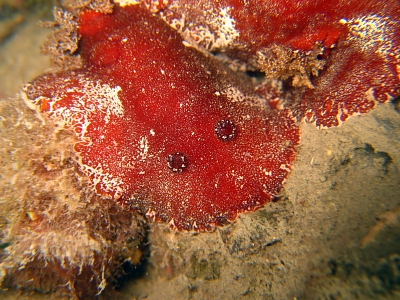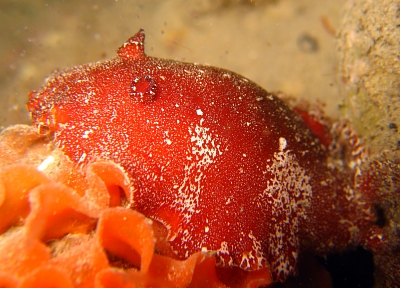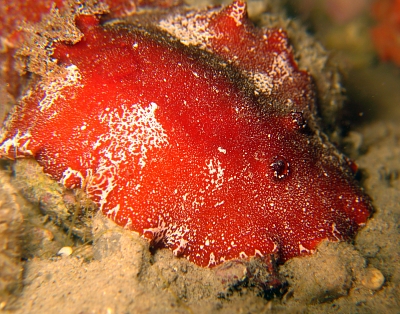Platydoris argo from southern France
July 28, 2008
From: Dominique Horst


Hello Bill,
I've a couple of Platydoris argo with their eggs ribbon. As you can see their colour is dark red. If the general colour (included eggs) depends on their food, I'm puzzled about what can be this food. I did not see any red orange sponge around, as they are living on mud .... This colour was only on the gorgonian Lophogorgia ceratophyta... Could this be their food?
Locality: Cagnes, 8 m, France, Mediterranean sea, 1 July 2008, muddy. Length: 60 mm. Photographer: Dominique Horst.
Kind regards,
Dom.
dominique.horst@wanadoo.fr
Horst, D., 2008 (Jul 28) Platydoris argo from southern France. [Message in] Sea Slug Forum. Australian Museum, Sydney. Available from http://www.seaslugforum.net/find/21673
Dear Dom,
Only some sea slugs make use of colour pigments from their food. Some transparent or semi-transparent species with very branching digestive glands take on the colour of their food because we can see it in their digestive system. A few others actually remove colour pigments from their food and incorporate the pigments into their skin. However many of them produce their skin colour genetically. Some have evolved colour patterns to match the colour of their food, but many others have colours which make the animals blatantly obvious. Have a look at the Fact Sheet on colour in sea slugs and the pages on Defence - Colour patterns, and Camouflage.
I am sure P. argo is not eating gorgonians. Concerning the whereabouts of the sponge it is eating. Many sponges are able to survive being covered with a fine layer of silt and debris which can completely hide the presence of the sponge colony. Many can also survive being overgrown by algae. I suspect from your photos that their sponge food is nearby but it is either hidden in a crevice or under a rock, or is covered in a layer of silt or algae. I know the last thing you want to do when diving is to disturb the bottom and make the water murky, but that might be the way to find their food.
Best wishes,
Bill Rudman
Related messages
-
Re: Alien nudibranchs from Maltese waters?
From: Alan Deidun, April 1, 2010 -
Alien nudibranchs from Maltese waters?
From: Alan Deidun, March 30, 2010 -
Platydoris argo with damaged mantle
From: Dominique Horst, September 8, 2008 -
Re: Unidentified dorid from the Adriatic Sea
From: Sven De Vos, August 11, 2008 -
Unidentified specimen from Corsica, France
From: François Zylberman, April 24, 2008 -
Platydoris argo from Portugal
From: Joao Pedro Tojal Loia Soares Silva, April 23, 2008 -
Unidentified dorid from the Adriatic Sea
From: M. Angelozzi, November 7, 2006 -
Platydoris argo from the Canary Islands
From: Christian Kowalewski, August 28, 2006 -
Platydoris argo from Turkey
From: Umut Tural, November 28, 2003 -
Re: Platydoris argo from Turkey
From: Ron Velarde, July 31, 2003 -
Platydoris argo from Turkey
From: Ferda Buyukbaykal, July 24, 2003 -
Platydoris argo from Turkey
From: Haluk Akbatur, July 24, 2003 -
Platydoris argo from French Mediterranean
From: Marina Poddubetskaia, July 22, 2002 -
Platydoris argo from Spain
From: Erwin Koehler, August 11, 2000 -
'Trailing' in Platydoris argo
From: Eriwn Koehler, August 11, 2000 -
Re: Platydoris? from Atlantic
From: Angel Valdes, August 2, 2000 -
Re: Platydoris? from Atlantic
From: Juan Lucas Cervera, August 2, 2000 -
Platydoris? from Atlantic
From: Erwin Koehler, July 30, 2000
